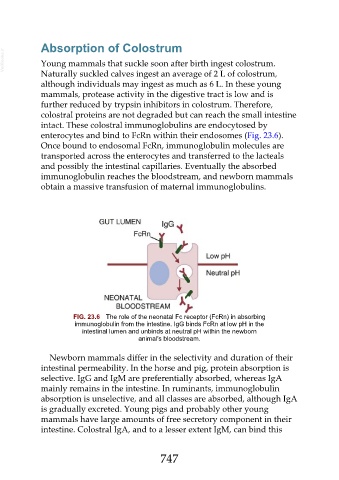Page 747 - Veterinary Immunology, 10th Edition
P. 747
Absorption of Colostrum
VetBooks.ir Young mammals that suckle soon after birth ingest colostrum.
Naturally suckled calves ingest an average of 2 L of colostrum,
although individuals may ingest as much as 6 L. In these young
mammals, protease activity in the digestive tract is low and is
further reduced by trypsin inhibitors in colostrum. Therefore,
colostral proteins are not degraded but can reach the small intestine
intact. These colostral immunoglobulins are endocytosed by
enterocytes and bind to FcRn within their endosomes (Fig. 23.6).
Once bound to endosomal FcRn, immunoglobulin molecules are
transported across the enterocytes and transferred to the lacteals
and possibly the intestinal capillaries. Eventually the absorbed
immunoglobulin reaches the bloodstream, and newborn mammals
obtain a massive transfusion of maternal immunoglobulins.
FIG. 23.6 The role of the neonatal Fc receptor (FcRn) in absorbing
immunoglobulin from the intestine. IgG binds FcRn at low pH in the
intestinal lumen and unbinds at neutral pH within the newborn
animal's bloodstream.
Newborn mammals differ in the selectivity and duration of their
intestinal permeability. In the horse and pig, protein absorption is
selective. IgG and IgM are preferentially absorbed, whereas IgA
mainly remains in the intestine. In ruminants, immunoglobulin
absorption is unselective, and all classes are absorbed, although IgA
is gradually excreted. Young pigs and probably other young
mammals have large amounts of free secretory component in their
intestine. Colostral IgA, and to a lesser extent IgM, can bind this
747

